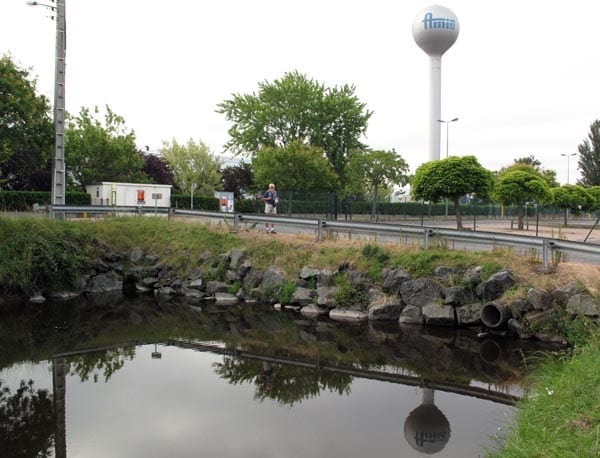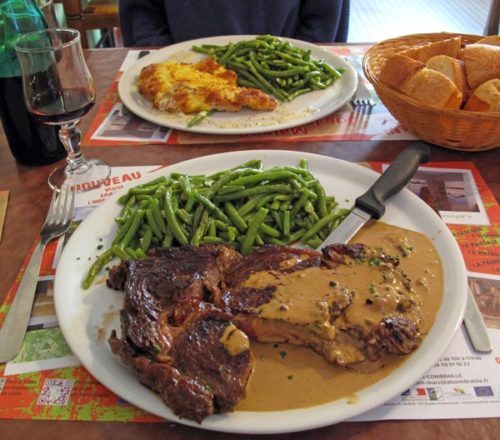
Saturday, 21 July 2012
Distance 24 km
Duration 5 hours 25 minutes
Ascent 21 m, descent 64 m
Map 140 of the TOP100 lime-green series
Having slept soundly through a night of drizzle, we rose and ate our customary muesli in the room. Keith added a couple of painkillers to his, in preparation for the exertions ahead.
We crept downstairs at 7:10 am and were surprised to see the breakfast room already operating busily. The usual breakfast hour in French hotels is eight o’clock.
Outside in the chilly street, feeling rather envious of our fellow hotel guests with their coffee and warm pastries, we retraced our steps to the main circular boulevard. There, on the corner, next to the pavement fountain, was a bakery (one of the Pat’a’Pain chain), serving breakfasts for €3.90 – coffee, orange juice, fresh bread, butter and jam.

Welcoming light spilled out onto the damp street and people bustled in and out. We went in and took one of the tables near the door, which was draughty but there seemed to be nowhere else to sit. Only as we were leaving did we notice a whole warm room upstairs on the mezzanine floor.
The breakfast was delicious, especially the butter, a luxury that hardly ever passes our lips in France. I arranged my hat and a serviette over my bare legs and managed to keep out the cold breeze.
We left half an hour later, following the directions of the helpful man at the Office of Tourism, going over the bridge to the Rue du Canal, where there was no longer a canal at all. This part of it, where it had joined the river, had been filled in long ago, leaving only a wide lane between the dark old factory buildings.

Further on there was some attempt at gentrification – lawns and flower beds, a community centre – and gradually the houses thinned out. We scrambled up a bank to cross a main road, then continued along the edge of the dry space that had once been the canal, but was now planted with small, lopped trees. New factories had sprung up along the way.
Suddenly, at a cross street, we found ourselves beside the canal proper. The stump of the amputated, filled-in section was lined with rocks and inset with pipes, presumably going back to the river.
We were delighted to be once more on the familiar canal that we had followed last year for such a long way (on its lower reach from Mehun-sur-Yèvre to its junction with the Cher). It also meant the end of several days of walking on bitumen.

At first the canal passed by some of the decrepit old factories that had been the reason for the canal’s construction in the first place.
Montluçon had been an early producer of coal and iron, as well as of agricultural goods, but access to markets was slow and arduous until the canal was built in the early nineteenth century.
After that, goods could be floated down to the Loire and from there to anywhere in the world. It only lasted a century before rail and road superseded it.

There was a towpath on either side, as usual, and although many of the original trees were now gone, there was plenty of shade.
We swung along at an easy pace, enjoying the peace and familiarity of the scene. The water was like green glass and the absolute flatness of the track was good for Keith’s leg.
It took us nearly two hours on the towpath to reach the village of Vaux and the first thing we saw was a fine old pink-shuttered building beside the canal, now a bar/restaurant but probably a hotel in former times.

There was a marquee out the front with tables set for lunch, so we sat down gratefully and ordered coffee. It was 10:15 am, a good time for a break.
The waiter had no croissants but told us that there was a boulangerie at the back of the building, so I darted round and found it in a little wooden cabin.
The baker was sorry that he only had a few things left, but I managed to get a baguette and a little quiche Lorraine, which slipped down very well with the coffee.

Keith had some bread too, with the jam that we had saved from breakfast. He was going so well that he did not need another pill.
We continued slowly, nursing Keith’s injury. Once in a while the silence would be broken by the roar of a train, unseen behind the bordering trees. The railway line was never far from the canal, using the same flat route.

There were many locks on the canal and after about half an hour we came to a lock-keeper’s cottage with a plaque announcing that François Mitterand’s grandfather had been born there.

At another lock-keeper’s cottage, a man emerged to ask us what we were up to.
We said we were trying to complete our tour of the canal, after following other bits of it in two previous trips, and he seemed to think this was a perfectly normal thing to do, which we found reassuring.
He volunteered the information that the canal was blocked just beyond Vallon, but after that it was open again.

Further on, at Magnette, our hopes were raised by the sight of a marquee behind an old stone house, which turned out to be a museum dedicated to the history of the canal.
Magnette had been a stopping point (une gare d’eau) for the longboats on the canal. However it was not open when we went by.
The last section seemed long and monotonous This is often the case on canals, because the scenery, while delightful, does not vary much. The only interest was provided by occasional information panels. We were getting tired and Keith’s leg was starting to trouble him again.
After going under the autoroute, we had to guess which side of the canal to walk on. We knew the camping ground of Vallon-en-Sully was beside the canal, but we did not know whether it was on the right or the left bank and there was no bridge for a long way. We chose the right bank and immediately regretted it, but trudged on miserably. Suddenly we saw a large lawn on our side, with tents and caravans – our wild guess had been right after all.

Scrambling down from the towpath, Keith stumbled and twisted his already painful leg, but at least we could then stop and recover. It was 1:45 pm by this time, so the first thing we did was to sink down onto our mats and have lunch.
Nothing much happened after that until we gathered the strength to try the showers. What the women’s showers lacked in quantity (there was only one) was made up for in quality. The water was hot, copious and controllable, while the cubicle was large enough for me to wash all the things that had escaped my attentions the day before, at the hotel.
With our wet clothes strung out between two trees, we lay down for another rest, but it was surprisingly chilly in the shade, too cold for comfort.
Instead we went for a stroll into the village, which was a bit further along the canal, looking for somewhere to have dinner tonight.

There was a place in the camping ground itself and another on the edge of the village. Both were unprepossessing but adequate.
We crossed the railway line and climbed into the main street, where we found a pretty little café with pink umbrellas adorning its terrace. Inside, out of the breeze, a large TV was showing the time trial of the second-last day of the Tour.
As we sipped our drinks, I asked the barman about the way ahead. His response was that the canal only went south from here, not north, but that if we walked out along the road and turned off at the graveyard, we would find it again. However there were other blockages further on, he warned.

Walking back to the camping ground, we realised that the grassy strip of land with tennis courts beside the railway line was the filled-in bed of the canal. Somehow it was a sad sight. On the other side of the road the widened canal basin was full of cheerful-looking electric boats.
The Canal de Berry was officially closed in 1955, after years of declining use, and sold off at absurdly cheap prices to the local communes, some of whom preserved it as a waterway, while others drained it, or even filled it in. Now there is a move afoot to reclaim the whole length of it for the use of pleasure boats.
Keith’s leg was hurting more than ever after his awkward descent from the levee bank, and he was shuffling like an invalid. With difficulty we got back to the flower-decked gates of the camping, where two girls in bikinis rose from sun-baking on the grass beside the little reception hut and took our €6.40. Their tiny tent was pitched nearby.

For the last part of the afternoon we lay in our tent, as there was nothing else that we could do. Fortunately we had plenty to read.
At dinner time we chose the nearest restaurant, the one next to the camping ground, on the levee bank of the Cher (the camping ground was between the levee banks of the canal and the river). Plenty of people were there, most of them eating on the terrace, which had a pleasant view across the river, but we thought it was too cold so we went inside.
The menu was small but good. We decided to have only one dish each, instead of the several courses that we often had, and it was just as well – the meals that we got were heroic.

Keith chose his unwavering steak, with green peppercorn sauce, while I had the leg of a large fowl enveloped in golden cheese. We managed to exchange the chips for a pile of delicious green beans, and there was the usual abundance of bread and wine.
From this simple but delectable feast we took away enough bread, chicken and steak to make a handsome lunch for the next day.
Back in the tent, Keith took two aspirins to reduce the pain enough to let him sleep, and it worked well.
Previous section: St-Hilaire-le-Château to Montluçon